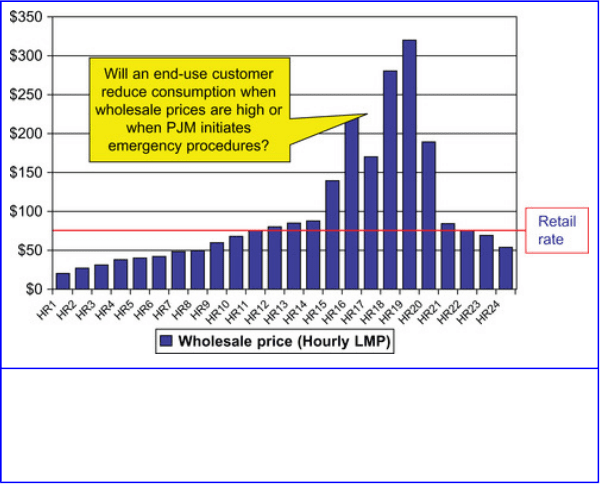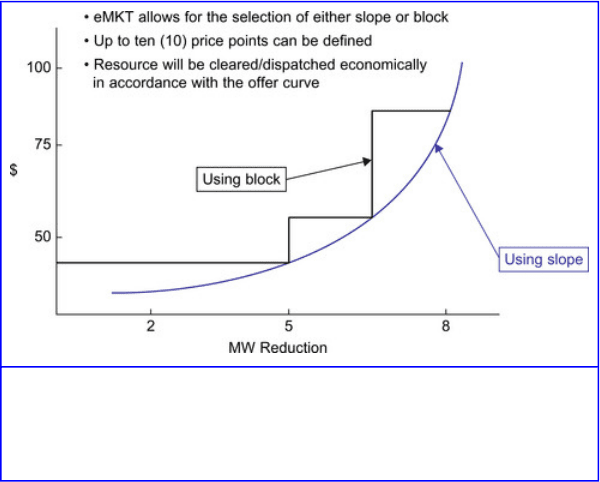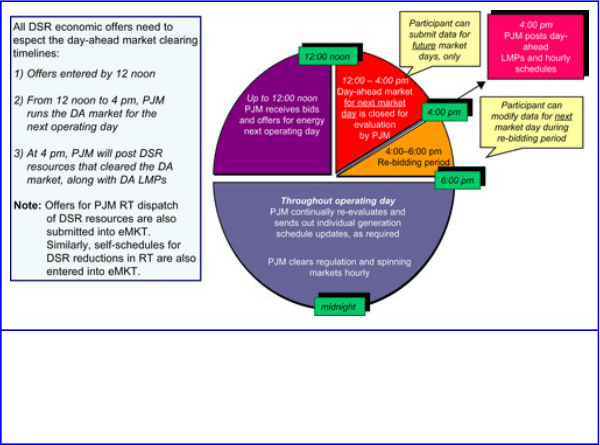Sioshansi F.P. Smart Grid: Integrating Renewable, Distributed & Efficient Energy
Подождите немного. Документ загружается.


Energy Market Benefits of Integrating Economic Load
Response
The incorporation of DR in the Energy Market allows
end-user customers to express their willingness to pay for
power, which enhances market efficiency relative to markets
where consumer demand is taken as a given regardless of
price. As consumers are allowed to respond to prices (and
provide additional supply), market competitiveness is
enhanced, and potential exercises of supplier-market power
are checked as any supplier attempts to raise price will result
in a corresponding reduction in demand, making such
attempts less profitable. At the level of the end-use customer,
the incorporation of DR in the Energy Market provides the
opportunity to control electricity expenditures. The
empowerment of end-use customers to reduce demand in
response to high energy prices provides a mechanism to
control the total electric bill while providing reliability
benefits in short-term operations.
History
DR participation in PJM's Energy Markets can be traced back
to 2002 when following forms of DR participation in the
Energy Market were approved by the FERC: (1) DR in
response to price, known as Economic Load Response,
15
and
(2) at the direction of PJM Operations, known as Emergency
Load Response.
16
The FERC Orders authorized these
Emergency and Economic Load Response Programs to run
for three summers, 2002, 2003 and 2004, and to expire on
December 1, 2004. The summers of 2003 and 2004 passed
831
with modest growth in the number of sites participating.
17
PJM developed and delivered DR training for market
participants, later known as Curtailment Service Providers
(CSPs) as described in section “Entities that Participate as DR
in PJM's Markets”.
18
In October 2004 FERC extended the
Emergency and Economic Load Response Programs until
December 31, 2007.
19
PJM later filed market rules for
permanently integrating demand response into the Energy
Market in late 2005.
20
FERC approval followed in early
2006.
21
15
PJM Interconnection, L.L.C., 99 FERC ¶61,227 (2002).
16
PJM Interconnection, L.L.C., 99 FERC ¶61,139 (2002).
17
167 sites representing 662.7 MW participated in the Emergency Load
Response Program and 248 sites representing 468.7 MW participated in
the Economic Load Response Program in 2003. 3,873 sites representing
1,557.9 MW participated in the Emergency Load Response Program and
2,466 sites representing 1,644.4 MW participated in the Economic Load
Response Program in 2004 according to the 2005 State of the Market
Report (pp. 72‒75). It is important to note that participating end-use sites
could only be registered in one of the programs at a time and that
participation as capacity referred to as Active Load Management was a
separate program.
18
The term “Curtailment Service Provider (CSP)” describes the function of
aggregating the load reduction capability of end-users for the purpose of
participating in PJM's markets. Any member or special member of PJM
can chose to fill the role of a CSP.
19
PJM Interconnection, L.L.C., Letter Order, Docket No. ER04-1193-000
(October 29, 2004).
832
20
PJM Interconnection, L.L.C., Initial Filing, Docket No. ER06-406-000
(December 28, 2005).
21
PJM Interconnection, L.L.C., 114 FERC ¶61,201 (2006).
Incentives to Respond to Prices. Figure 17.5 highlights the
incentives that end-use customers, LSEs, EDCs, and CSPs,
have in responding to prices whether it is for economic
reasons, or in an emergency. End-users paying flat, fixed rates
at the retail level have little incentive to reduce usage during
periods of high prices at the wholesale level or during
emergencies as they face the same flat retail rate regardless.
However, if the end-use customer works through PJM
members that are wholesale market participants and that can
directly see and are exposed to wholesale energy prices
(Locational Marginal Prices or LMPs), both the end-use
customer and the wholesale market participant can work
together to effectively create a dynamic rate through the
combination of retail and wholesale prices that can benefit
both parties.
22
22
See Chapter 3 in this volume for more detailed analysis of dynamic retail
pricing.
833

Figure 17.5
Incentives for end-use customers to respond to wholesale prices.
Source: PJM
In Figure 17.5, when wholesale prices are above the retail
rate, a reduction in energy consumption by an end-use
customer in hour ending 20 will result in a savings of just
over $300/MWh in the wholesale market to the LSE that
serves the end-use customer. However, the LSE also does not
sell that same MW of energy at the flat retail rate of
approximately $70/MWh in Figure 17.5. On net the LSE
saves the $300/MWh wholesale price (LMP) (power it did not
have to buy in the wholesale market), but does not sell the
$70/MWh retail energy, thereby realizing a net savings of
$230/MWh. This net savings is often referred to as “LMP
minus G,” where G represents the retail rate. Moreover, since
prices during emergency conditions are likely to be very high,
the economic incentives to reduce energy consumption
coincide with the needs of the system for energy reductions to
834

help maintain reliability. The manner in which the LSE (or
CSP) splits the savings between itself and the end-use
customer is a contractual matter between the parties and is not
overseen by PJM.
Market Mechanics
In PJM's Energy Market, registered DR participates in
Economic Load Response by reducing electricity
consumption when LMPs are high relative to the retail price
paid by the participating end-use site. Economic Load
Response enables users for the first time to see and respond to
dynamic wholesale electricity prices and to benefit from
changing normal usage patterns in response to LMP prices
that are significantly higher than the generation and
transmission portion of the retail rates they are charged.
Participation in Economic Load Response can occur in either
the Day-Ahead or Real-Time Energy Markets. All
DR—except, DR that purchases electricity pursuant to
contracts with Real-Time LMP prices—is eligible to
participate in the Day-Ahead Energy Market.
CSPs offering load reductions in the Day-Ahead Energy
Market on behalf of registered end-use sites may offer of a
quantity of load reduction at a price, as well as shutdown
costs and minimum down times for which the reduction must
be committed, like the price, quantity, start-up costs, and
minimum run times of generators. Load reduction offers that
clear in the Day-Ahead Market receive the Day-Ahead LMP.
Like generators, registered DR may provide up to 10 price,
quantity pairs in eMarket that are used to clear the Day-Ahead
Energy Market. Any deviations from Day-Ahead
commitments are settled at the Real-Time LMP along with
835

applicable Balancing Operating Reserve charges.
Participation by DR in the Day-Ahead Energy Market has
been relatively light.
CSPs have two options for participation in the Real-Time
Energy Market as part of Economic Load Response: real-time
dispatch or as a self-scheduled resource. To be dispatched in
the Real-Time Energy Market using the Unit Dispatch System
(UDS), a CSP submits an offer for a DR resource that
indicates an LMP strike price, a price at or above which the
DR commits to make a reduction, the time needed to shut
down, and the minimum time the end-use site must reduce
load. Likewise, registered DR may provide up to 10 price,
quantity pairs in eMarket for use by the Unit Dispatch
Software (UDS) as shown in Figure 17.6.
Figure 17.6
Example of a DR offer curve in the energy market.
Source: PJM
836

To exercise the self-schedule option, the CSP must provide
notification to PJM no less than five minutes prior, and no
more than seven days prior, to the demand reduction. The
notification must include the start and stop times for the
demand reduction as well as the quantity of the demand
reduction.
Figure 17.7 illustrates how the CSP can utilize the three
options for participating as Economic Load Response in the
Energy Market: offer into the Day-Ahead Market, offer to be
dispatchable by PJM in real time, or self-schedule the load
reduction through the notification process in real time.
Figure 17.7
Options for DR participation in PJM's energy markets.
Source: PJM
The CSP may submit a load reduction offer in the Day-Ahead
Market by noon of the day before the operating day. PJM
evaluates the offer including the shutdown costs and
minimum down time. If the offer clears in the Day-Ahead
837

Market, then the CSP will be notified by 4:00 PM of the day
before the operating day. If the offer does not clear in the
Day-Ahead market, the CSP may submit the same offer or a
new offer on behalf of the end-use site for dispatch by PJM in
the Real-Time Market. PJM will continually re-evaluate the
offer by comparing alternatives throughout the operating day.
If PJM dispatches the load reduction in real time, then an
email notification will be sent to the CSP. Finally, if PJM
does not dispatch the load reduction in real time, the CSP may
at the end-use customer's direction self-schedule the load
reduction.
Measuring Load Reductions
The load reduction quantity for any hour is the difference
between the calculated Customer Baseline Load (CBL) and
the metered usage. The CBL is an approximation of what the
DR resource would have consumed absent the reduction and
is the mechanism that enables DR to effectively be
represented as a supply-side resource in the PJM Energy
Market software. CSPs must submit load reduction
settlements within 60 days of the Load Reduction Event. The
60-day period accommodates end-use sites that rely on EDC
meter readings for the settlement of Economic Load Response
activity. Many EDCs require 60 days to provide “billing
quality” meter data for these settlements.
Participating end-use sites must have metering equipment that
provides hourly integrated kWh values. The exception to this
rule is the aggregation of registered end-use sites that achieve
load reductions through switches that the CSP controls using
radio signals or power line communications. The stakeholders
838

developed metering requirements for non-EDC hourly
interval meters including pulse recorders in 2008.
23
23
PJM Interconnection, L.L.C., Initial Filing, Docket No. ER09-1508-000
(July 28, 2009).
The applicable EDC or LSE serving the end-use site has the
option to review the settlement data provided by the CSP and
to indicate to PJM if the load reduction was the result of the
plant's annual shutdown, for example, rather than a change in
usage in response to wholesale price signals. Approved
settlements are paid by PJM on the basis of the quantity of the
load reduction times the difference between the zonal,
aggregate, or nodal (as applicable) LMP and the end-use
customer's generation plus transmission charge (also referred
to as the “retail rate”). The total savings for a DR resource for
each MWh of reduction are equal to the avoided retail rate
expenditure plus the payment of the LMP minus the retail
rate, which adds up to a savings of the applicable LMP.
Settlements in the Energy Market
PJM, in order to pay a settlement or credit the CSP for the
end-use customer's Economic Load Reduction activity, must
collect the equivalent amount or debit from another wholesale
market participant. PJM has put in place a settlement and
accounting mechanism that accomplishes both the payment to
the CSP and the collection from the LSE serving the end-use
customer. The following hypothetical demonstrates how the
settlement and accounting mechanism works.
An end-user site engaging in Economic Load Response would
receive the wholesale market price for energy, LMP, less the
839
applicable energy and transmission portion of the retail rate
G&T, LMP – G&T, for each MWh of energy consumption
avoided below its consumption baseline or CBL. If the G&T
rate is $70/MWh and the LMP is $100/MWh, the payment
received by the demand responder from the wholesale market
for a 1 MWh reduction in consumption is $30. PJM collects
the $30 payment from the end-use customer's LSE of record.
The end-use customer engaging in Economic Load Response
also avoids paying G&T, which in this hypothetical is $70/
MWh for each MWh of avoided energy consumption.
Therefore, the demand responding end-use customer obtains a
value of $100/MWh for its demand response in a wholesale
market context ($30/MWh direct payment plus $70/MWh
avoided cost). The LSE has now either saved $100 by
avoiding the purchase of electric power at $100/MWh (if
satisfying that obligation in the spot market), or has received
$100 from the spot market for the excess MW purchased for
but not consumed by the end-use customer.
Another way of viewing the settlement for DR resources
participating in Economic Load Response is that DR
resources are being exposed to the market price of electricity,
while still taking service under a regulated retail rate if being
served by a traditional EDC/LSE or at a competitive retail
rate if being served by a competitive LSE. DR can in this way
be exposed to market prices for reductions while remaining
hedged for remaining consumption at the retail rate.
There is in fact a subset of end-use customers that pay retail
rates that are not fixed, but are so-called “LMP-based” rates.
Customers on “LMP-based” rates already buy all or part of
their electricity at the Real-Time LMP wholesale price. Since
these customers already see wholesale market prices and see
840
